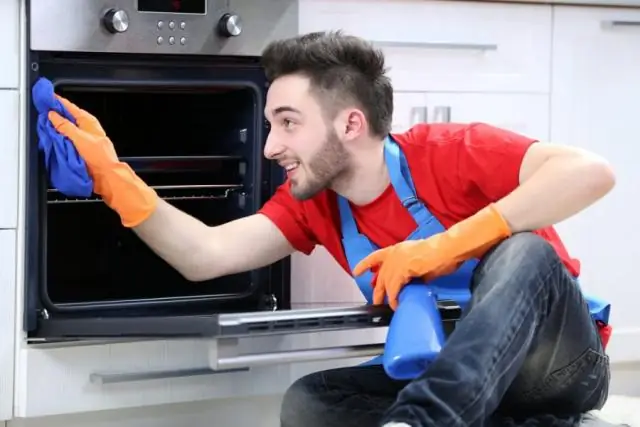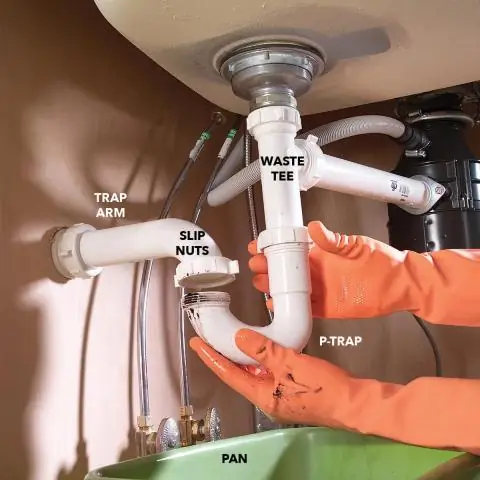
Table of contents:
- Author Bailey Albertson [email protected].
- Public 2023-12-17 12:53.
- Last modified 2025-06-01 07:32.
How to clean an electric oven from grease, carbon deposits and other stubborn dirt: proven methods

All manufacturers recommend cleaning the inside and outside of the oven immediately after each meal. The goal is to prevent the resulting contamination from burning. For this, liquid cleaners and a soft sponge are used. It is not necessary to use abrasive powders, hard sponges and metal brushes, as they can damage the enamel coating. How to properly clean the oven and what are the most effective products?
Content
- 1 Chemical cleaning
-
2 Traditional methods
- 2.1 Steam (hydrolysis cleaning)
- 2.2 Baking soda
- 2.3 Vinegar
- 2.4 Baking soda + vinegar
- 2.5 The traditional method is laundry soap
- 2.6 Table salt
- 2.7 Ammonia
- 2.8 Lemon juice
-
3 Self-cleaning systems for electric ovens
- 3.1 EasyClean self-cleaning system
- 3.2 Catalytic cleaning
- 3.3 EcoClean cleaning system
- 3.4 Pyrolytic cleaning
- 3.5 Video: Electric Ovens - Self-Cleaning Methods
- 4 Summing up
-
5 How to remove odors from the oven?
- 5.1 Lemon peels
- 5.2 Apple cider vinegar
- 5.3 Salt
Chemical cleaning
In retail outlets, there are richest proposals for the selection of all kinds of gels for cleaning electric ovens, ovens and other heating devices used in home and professional kitchens. In built-in ovens, skilled housewives bake delicious meals with hot air. An electric oven has a lot of advantages, but there are also significant disadvantages. First of all, it is the release of fat vapors, own juice of products and other formations, which lead to the appearance of pollution. Commercials tirelessly talk about the merits of Frosch, "Mister Muscle", "Shumanita", "Silit Benga", "Medic Anti-Fat" and other liquid cleaners.

The variety of cleaning products is impressive
But, chemistry is chemistry. Its harmful traces can get into food. Some chemicals have a strong odor that spreads throughout the kitchen. Others are not as effective at fighting pollution. Most gels require the use of protective equipment - gloves, respirators, masks - and good ventilation. Gels, with the addition of a small amount of water, form a copious foam that easily copes with greasy stains and stubborn deposits. Therefore, it is enough to sprinkle a household chemical gel on the contaminated areas and wait for a period (the method of application is written on the package). All dirt spots will fall behind. Then they are washed off with warm water.
Traditional methods
Steam (hydrolysis cleaning)

Using steam is a budget and safe option
This is an affordable, effective, proven way to clean the oven's interior enamel coatings of long-standing dirt deposits. Water is poured into a baking sheet, a little liquid soap or dishwashing detergent is added. The container is placed in the oven and the thermal mode is turned on (about 120 degrees Celsius). As soon as the water boils, reduce the temperature to 110 degrees and boil for at least 30 minutes. If this time is not enough to steam the dirt, increase the steam generation time to one hour. Then turn off the oven and cool to room temperature. Wash off dirt deposits with a sponge dipped in warm soapy water. Be sure to wipe all surfaces with a dry cloth.
Baking soda

Baking soda is a must-have in any kitchen
Many housewives use ordinary baking soda not only for additives in food, but also as a universal cleaning agent for kitchen utensils. It also copes well with dirt inside the thermal chamber of the oven, including the glass of the door. Dilute a third of a glass of baking soda with a little water - until a thick mass is formed. In the evening, apply this paste to dirty places and leave until morning. Then wipe off the mixture of soda and dirt with a damp sponge and rinse with warm clean water. The effectiveness of the cleaning properties of soda can be enhanced by adding ordinary table salt in the proportion: add one part of salt to four parts of soda.
Good results are obtained by using a baking powder (a mixture of baking soda and citric acid in a 1: 1 ratio). If the baking powder is applied to the wetted surfaces of the oven, then after a while the fat will lag behind the enamel surface. A sponge dampened with soapy water will easily wash away dirty solution from the inside of the oven.
Vinegar

Vinegar contains acids, so for some surfaces it is better to choose a different cleaning option
Light dirt is washed off with a mixture of water and vinegar in a 1: 1 ratio. To do this, a mixture of vinegar and water is applied to the inner walls of the oven with a spray gun, the oven is turned on at a temperature of +50 degrees. After holding for a quarter of an hour, dirt can be easily removed with a sponge and warm clean water. Vinegar perfectly removes soot with impurities of fat, so the heat chamber near the oven will look like new.
Baking soda + vinegar
Vinegar essence and sodium bicarbonate (baking soda) chemically react with each other and release carbon dioxide. He can easily cope even with old fat deposits. To start cleaning the oven heat chamber and door with a mixture of acid and alkali, proceed as follows:
- Spray vinegar on all surfaces inside the heating chamber.
- Pour soda onto a moistened sponge and treat the dirt with it. Open the door fully and sprinkle with baking soda as well.
- Let the treated surfaces stand for several hours so that the vinegar and soda break down the old fat as efficiently as possible.
- Put some baking soda on a semi-hard sponge and wipe the walls, baking sheets, bottom and door without pressure.
- Wash all cleaned surfaces with warm water.
The traditional method is laundry soap

The higher the percentage of fatty acids (72% in the picture), the more effective the soap will cope with dirt
Laundry soap does not contain any chemical impurities, therefore it is safe for health and does not harm the environment. Effective removal of dirt occurs due to the alkaline environment, which is formed when the soap is diluted with water. The cleaning procedure is as follows:
- Grate 50 grams of laundry soap on a fine grater.
- Dissolve the formed shavings in a container with boiling water.
- Put the container in the oven and turn on the temperature at 150 degrees.
- Let the "soapy water" simmer for about one hour.
- Grease stains, burn-in, stuck-on dirt are carefully removed with a semi-hard sponge.
- All surfaces are washed with clean water.
- The oven door remains open during the day so that the specific smell of laundry soap disappears.
Salt

Due to the presence of sodium and chlorine in its composition, ordinary salt will help get rid of carbon deposits and dirt
It is one of the most affordable, effective and fast-acting home cleaning products. Sodium and chlorine, when heated, destroy old fat deposits, make them loose and soft. The algorithm of actions is the simplest:
- Sprinkle salt on horizontal surfaces: baking sheets, trays, shelves and the bottom of the oven heating chamber.
- Turn on the heating and bring the temperature regime to values at which the salt will take on a golden hue.
- Unplug the oven and let it cool down.
- Rinse the door, walls, trays, trays and bottom with warm water and a little liquid foaming dish detergent.
- Rinse all surfaces with clean water and dry with a paper towel.
Ammonia

You can buy ammonia at any pharmacy
This way you can fight the most stubborn dirt. The ammonia will be able to return the pristine purity of even the oldest oven. Cleaning can be done in two ways - hot and cold. In the first case, ammonia is applied with a generously moistened sponge to all internal surfaces in the oven and kept for 8-12 hours. Then all dirt is removed with warm water with the addition of a small amount of detergent. In the second case, two small containers are placed in the oven: with ammonia - on the upper shelf, with water - on the lower one. The oven heats up to 100 degrees (the water must boil). Then it is disconnected from the network, the door is closed and it cools down during the night. In the morning, the liquids from both containers are mixed with a small amount of dishwashing liquid. This solution is applied to the inner surfaces of the oven and then washed off with warm clean water. The effect will be excellent.
Lemon juice

Lemon will not only clean the oven, but also remove unpleasant odors
Citric acid easily removes grease stains. There are two options here too. In the first case, juice is squeezed out of the lemon, which is mixed with an equal amount of water. Internal surfaces are treated with this liquid. In the second case, lemon slices are placed in a container with water and a small amount of dish detergent is added. Put the container in an oven preheated to 100 degrees and stand for 30-40 minutes. Allow to cool, then use a sponge and this mixture to remove all grease from the walls, baking sheets, bottom and door of the oven.
Self-cleaning systems for electric ovens
The self-cleaning function was invented for professional kitchen equipment. But technologies are improving, becoming cheaper and more affordable for a conventional electric built-in oven. Many housewives are happy to save themselves from the tedious and messy work of cleaning the oven from accumulated fat deposits.
Easy self-cleaning EasyClean system
The most common self-cleaning technology (used on models of all manufacturers) is the lining of the inner walls of the oven with special coatings made of easy-to-clean smooth enamels. Such coatings do not absorb dirt at all. This cleaning system is called EasyClean. It is easy to use it:
- Pour some water into a special depression in the bottom of the oven (a little less than half a glass).
- Add a few drops of special detergent.
- Turn on the oven heat mode 100 degrees for 25-30 minutes.
- Collect all dirt from the bottom of the oven with a sponge, which will settle there along with the hot condensate of steam from the cleaner.
- Wipe all surfaces with a paper towel.
Catalytic cleaning
The catalytic cleaning of the built-in oven is the chemical decomposition of fats into simple components: water, soot (carbon) and organic matter without the formation of carbon deposits. At the same time, these constituents are absorbed by the sorbent formed from nanoparticles. These actions are caused by oxidizing agents that are part of the special coating. This porous enamel can only be applied to the side walls or all interior surfaces of the built-in oven. The catalytic cleaning system starts automatically when the temperature in the oven reaches 140 degrees. It is most effective at a temperature of 200 degrees.
Some manufacturers enhance the cleaning effect of the coating with a special built-in catalyst. In the models of the Miele concern, this device is called AirClean, in Siemens ovens - AktiKat. All manufacturers use catalytic cleaning. This cleaning method is recommended for those housewives who often use an electric oven for cooking, but want to save on oven costs and energy consumption. The disadvantages of this method include:
- manual washing of baking sheets, grates, grills;
- periodic hand washing of surfaces to remove not completely absorbed soot;
- the efficiency of fat decomposition is sharply reduced when dairy and sweet products hit the catalytic surface;
- requires frequent use of the oven to cope with large grease contamination;
- limited service life of the coating of 4-5 years.
EcoClean cleaning system
This system is still a world novelty. It is widely used mainly by two manufacturers: Bosch and Siemens, but other companies are also interested in it.

EcoClean self-cleaning kit from Bosch
The innovation is the use of a new high-quality ceramic coating EcoClean for self-cleaning of the oven. This type of cleaning starts automatically when the oven is turned on and warmed up to 270 degrees. In this case, all the resulting contamination turns into an easily removable plaque. Up to 80% of all odors are absorbed at the same time. The know-how of the invention lies in the use of the smallest ceramic balls, which break up carbon deposits when heated strongly. They have an amazing ability to independently restore their unique properties at high temperatures, which makes this coating durable. This coating is only applied to the rear wall. Other interior surfaces with EcoClean ceramics are sold separately.
Pyrolytic cleaning
Pyrolysis is an effective technological method in which all impurities inside the oven are burned. The hard pyrolysis mode is activated using a special button. The thermal regime reaches a temperature of 500 degrees. The door is automatically locked against accidental opening. Pyrolysis requires additional electricity consumption, so the models of such ovens are equipped with powerful heating elements. When they are turned on, all fatty deposits turn into ash, which can be easily removed with a damp sponge or tissue. All control over the pyrolysis process is entrusted to electronics. Several glasses are installed in the door (if this function is available) in order to prevent strong heating of the outer glass.

Pyrolytic cleaning results
This cleaning method is not without its drawbacks. Burning fatty soiling produces a persistent odor. Powerful ventilation is required to remove it. The main weak point of ovens with this self-cleaning method is the high price. Cleaning using pyrolysis is widely used in their models by manufacturers such as Bosch, Ariston, Siemens, Miele. Moreover, Siemens uses a special glass for the oven door, which is also cleared of fat when the pyrolysis mode is turned on.
Video: Electric Ovens - Self-Cleaning Methods
Let's sum up
- If the electric oven is used occasionally, steam cleaning is the best recommendation.
- If food is prepared in the built-in oven at least once a week - cleaning with a catalyst or ecoClean coating.
- If the oven is used much more often - powerful cleaning by pyrolysis.
When choosing an oven, many practical housewives pay attention not only to the access and convenience of manual cleaning to the internal surfaces (the absence of seams, protrusions, indentations, a folding grill, etc.), the presence of a self-cleaning system, but also to the possibility of cleaning the space between the glass of the door. Different manufacturers have different ways to disassemble the door. You need to carefully study the operating instructions: someone needs to first remove the door, and then disassemble it with a Phillips screwdriver; for others, the glass can be removed without removing the door, without using a tool.
How to remove odors from the oven?
Lemon peels
- Pour water into a small metal bowl.
- Add lemon or orange peels.
- Put in the oven.
- Turn on the temperature of 100 degrees.
- Boil water in it for 10-15 minutes.
Apple vinegar
Quickly removes unpleasant odors from regular apple cider vinegar. Moisten a napkin with it and wipe the inner surfaces of the oven heating chamber.
Salt
Table salt is an effective absorbent and easily absorbs all odors. Pour half a glass of salt on a baking sheet and heat the built-in household oven to 150 degrees. Keep at this temperature for about a quarter of an hour.
Cleanliness is the key to health. This axiom must be fulfilled even in the smallest detail. When baking food in the oven, fat is released, which will accumulate on the inner surfaces with each preparation of a new dish. Then he will start to smoke, filling the kitchen with an unpleasant smell. Contamination impairs the taste of the finished dish and negatively affects its appearance. Therefore, there is no need to accumulate fatty deposits in the oven, which before time make it old, unattractive, untidy. There are many ways to clean the oven from any contamination. The main thing is not to be lazy to regularly take care of your kitchen equipment.
Recommended:
How To Clean The Microwave From Fat Inside And Outside Quickly And Easily + Video

Practical step-by-step tips for cleaning your microwave oven from grease and dirt inside and out. Means used, precautions
Do-it-yourself Chimney Cleaning Using Potato Peelings, A Chainsaw And Other Methods, Including Folk, Instructions With A Video

You can maintain the chimney in the house yourself without resorting to the services of specialists. We will tell you how to clean the chimney with your own hands
Do-it-yourself Toaster Repair, How To Clean It Inside And How To Use It Correctly + Video

Features of the device toaster. Common types of breakdowns and their own repair. How to use the appliance to prevent its failure
How To Clean And Cut Fish Correctly: Methods Of Fillet Processing, What To Do To Prevent Scales From Flying, How To Gut And Other Recommendations + Video

How to clean fish properly. How can you cut it. Processing methods for different varieties. Step by step instructions. Photo and video
How To Clear A Blockage In A Bathroom: Ways To Clean A Bath Drain, A Siphon, A Mixer, A Pipe With A Cable And Other Means + Photo And Video

Reasons for blockage in the bathroom and its prevention. How to clean the drain and pipes: chemistry and mechanical cleaning. How to disassemble a siphon, mixer. Photo and video
